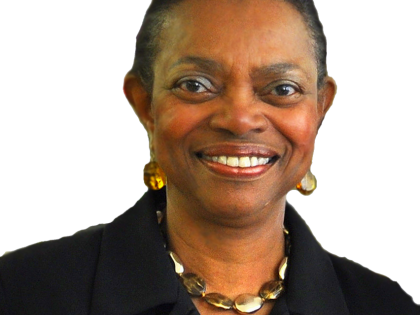
Unity Plan
Velmanette Montgomery
SENATOR MONTGOMERY ENDORSES UNITY PLAN AS FISCALLY RESPONSIBLE PROPOSAL FOR DOWNTOWN BROOKLYN AT FEBRUARY 24TH “DEMOCRACY & DEVELOPMENT” COMMUNITY FORUM
Blasts Bloomberg’s $100 Million in Subsidies to Build A Brooklyn Arena While City Schools Get Cut $1.3 Billion in Construction Costs
Mayor Bloomberg proposes to spend $100 million of City dollars to help Forest City Ratner build an arena in downtown Brooklyn. At the same time the Mayor is planning to cut $1.3 BILLION in school construction dollars. Under this plan, Brooklyn schools will be cut by $297 million and another $253 million will be delayed. These dollars are supposed to be used to build new schools, expand or upgrade existing schools and to perform much needed repairs. The $100 million subsidy to Ratner is in addition to a $300 million subsidy to build a stadium in Manhattan.
New York City and Brooklyn will feel the burden of massive budget cuts from the City and State because of mounting budget deficits and an ever expanding public debt. While the Mayor is planning to make huge cuts in the City School Construction budget, he is also counting on saving $325 million in pension and health insurance that city workers now enjoy. The Mayor is even squeezing $ 2 per hair cut out of city prisoners to create $100,000 in extra cash. Governor Pataki, as well, is planning to make huge cuts in the State’s health budget. Family Health Plus, a state insurance plan for the working poor, will be asked to cut dental and vision coverage and increase co-payments for doctor visits and prescription drugs. Brooklyn will also bear the burden of $50 million in cuts to hospitals putting them in danger of closing.
Senator Montgomery called construction subsidies to Forest City Ratner fiscally imprudent and foolish. “ The City debt per capita is now $6,223, according to City Comptroller William Thompson,” the Senator pointed out, adding that New York City leads other large US cities in debt burden per capita by a margin of 2.5 to one. This is not the time to build monuments to sports at the expense of city school children. What is worse is that Forest City Ratner is proposing to demolish a vibrant neighborhood displacing hundreds of people.
The Senator stressed that it is important to plan for responsible development over the Atlantic Avenue railroad yards. “Those 11 acres of public land are located in a world class location. They are next to a transportation hub which can take you to any location in NYC and Long Island and are surrounded by high value neighborhoods, cultural institutions, universities and colleges. They hold incredible potential,” the Senator stressed.
The Unity Plan, developed in workshops with local residents and urban planners, sponsored by City Council member Tish James, presents a new vision which treats the Atlantic railroad yards as a valued public resource. “I endorse the Unity Plan, the Senator said, because it calls for participatory development where competition would give local developers a piece of this valuable pie creating many more local jobs than if Forest City Ratner becomes the sole developer.” A public planning and development process, she added, can return broader long term benefits for Brooklyn and New York City. The Unity concept can provide answers to the dreams and needs of surrounding neighborhoods.”
Wednesday, February 16, 2005 • Edition of New York Press
It’s Not About the Arena
by Aaron Naparstek
Marshall Brown wants you to understand, “It’s not about the arena.” Mega-developer Forest City Ratner’s plan to bring the New Jersey Nets to a 19,000-seat Frank Gehry-designed arena atop Brooklyn’s old Atlantic Avenue Railyards is about one thing and one thing only. “It’s a very big real estate deal.”
Brown is rapidly becoming the Brooklyn version of Daniel Libeskind (but cooler, with no intimidating Teutonic wife, rectangular glasses or turtleneck). The dreadlocked 31-year-old urban designer is director of the Atlantic Yards development workshop and chief salesman of the UNITY plan, an innovative community-envisioned alternative to FCR’s $2.5 billion, 7.7-millionsquare-foot project.
Prospect Heights City Council member Tish James kicked off the development workshop almost a year ago. Having spent months walking door to door during her electoral campaign asking people what they wanted and needed in the neighborhood, she generated a lengthy laundry list. “Basketball arena” wasn’t on it. Spurred on by James, Brown and his three partners organized daylong session of brainstorming, visioning and community input followed by weeks of design. The result was the UNITY plan.
When you take a look at the UNITY plan the flaws in the Bloomberg administration’s general approach to development and FCR’s specific proposal become clear. The community-created plan includes space for a new school, recreation center and daycare, facilities that meet the needs Tish James found near the top of her list. It proposes a public park connected by a ribbon of greenway instead of a series of privately owned courtyards. Its lower-rise buildings mesh with the context and character of the surrounding neighborhoods yet manage to include more retail space and nearly the same amount of housing as the FCR plan.
The UNITY plan doesn’t require eminent domain or propose the demolition of any existing homes or businesses. It builds only atop the MTA’s railyards. Instead of creating the kind of windswept superblocks that proved to be such a failure at the pre-9/11 World Trade Center site, Brown’s team extends neighborhood streets through Atlantic Yards. This creates more frontage for retail and new connections between neighborhoods that have traditionally been cut off from each other. The smaller blocks also allow local construction firms to compete with one another for pieces of the project. “It’s like a pizza,” Brown says. “Sell it by the slice and you make more money.”
While FCR touts its ability to create jobs and affordable housing, Brown says, “We can go beyond housing and build homes. We can go beyond jobs and build businesses and careers.” Ultimately, this is the biggest innovation of the UNITY plan—the idea that those traditional political commodities, “jobs” and “housing,” aren’t good enough. For hundreds of millions of dollars of public money, New Yorkers should get more and expect better.
Share this Article or Press Release
Newsroom
Go to NewsroomNY Law Requires Parents in Prison Be Housed Closest to Kids
January 28, 2021
NY law requires parents in prison be housed closest to kids
January 3, 2021

